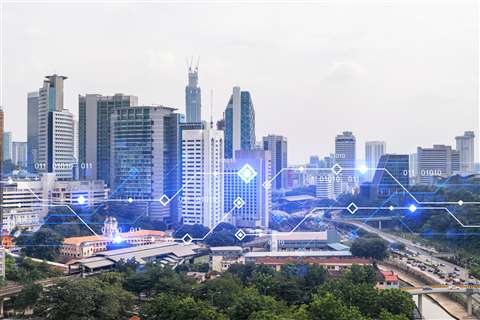How can digital twin technology improve sustainability?
11 January 2023
Arturo Leon, BIM sustainability manager at Spinview reviews the role of digital twins and visual intelligence in improving sustainability.
With regulation tightening across every industry a solid environmental, social and governance (ESG) strategy isn’t just about reputation, it makes commercial sense too.
 According to Arturo Leon, digital twins
According to Arturo Leon, digital twins
Companies with good ESG tend to benefit from improved valuation, better loans from banks and investors prioritising ESG, and enriched employment propositions for job seekers in this competitive market.
Still, while building a strong ESG track record is difficult in any industry, in few is the task more demanding than in the built environment.
Buildings are responsible for up to 40% of global energy consumption and 33% of greenhouse gas emissions.
Cement production is not only the largest contributor to carbon in the built environment, but its manufacture also accounts for some 7% of the world’s CO2 emissions.
And decision-makers now face another challenge: reducing the carbon generated by the built asset itself, also known as embodied carbon.
This includes emissions caused by extraction, manufacture, processing, transportation and assembly of every product and element in that asset.
Embodied carbon is expected to make up nearly 50% of the overall carbon footprint of new construction between now and 2050.
As urgent as the case for sustainable spaces may be, it is difficult to assemble an aligned environmental strategy for your built environment.
Collecting the complex web of environmental data in one place can be an uphill battle, to say nothing of mining it for insights.
The reason is that - in many organisations - most data is “dark data” existing in disparate formats and siloed systems that decision-makers can’t holistically access, much less interpret.
And then there is data on emissions and other invisible particulate matters that you may not have even captured yet.
The role of digital twins in sustainability
Now, however, with a new suite of technologies, decision-makers have more ways to collect, connect and communicate their data than ever before.
In the domain of sustainability, perhaps the most powerful of these is the digital twin, a 3D construction of your space that, when connected to various data sets from the real world, serves as a living, breathing recreation of your building or asset.
It responds and behaves like its real-world counterpart, a digital twin allows decision-makers to manage anything in their space remotely.
From insight and management of environmental emissions to forecasting the future performance of any asset or space, digital twins are fast becoming indispensable.
 Arturo Leon, BIM sustainability manager at Spinview. (Photo: Spinview)
Arturo Leon, BIM sustainability manager at Spinview. (Photo: Spinview)
For sustainability planners, one of the most critical data sets for an effective digital twin comes from environmental and health-based sensors.
Monitoring “invisibles” such as emissions, pollutants, humidity and noise, such devices generate a steady stream of environmental data that delivers powerful insights into how your asset is performing against an agreed set of criteria.
But collecting and connecting this information within a digital twin is only part of the challenge.
How do visual intelligence and digital twins
work together?
People must be empowered to act on these insights, and an advanced level of communication is needed – something that constantly communicates, that provides dynamic guidance and actionable intelligence to the people that really need it.
This advanced level of communication is called Visual Intelligence (VQ).
VQ is rapidly improving our ability to understand, communicate and respond to what the data in your digital twin is telling us.
It is the practice of translating data from mere information into a dynamic source of visual and actionable intelligence for everyone involved in the operation of your built environment.
How does visual intelligence reduce carbon footprint?
Once sensor-based environmental data is overlaid with a 2D or 3D digital twin, VQ creates a golden thread of rich visual insight that allows you to see your data in situ and to observe how changes impact the space and environment either in a moment, in recurring time slices or as a predictor of future states.
Thus, VQ is good news for companies that are currently striving towards net zero targets with little or no idea of what their carbon footprint is today.
Assisted by a VQ-powered digital twin, planners can establish a factual baseline of their assets and assess how far shy they are of their net-zero targets.
In addition, a VQ powered digital twin allows decision makers to visualize, assess and resource future scenarios.
This helps in the setting of realistic targets and roadmaps, shedding light on which levers to pull for energy savings. Swedish property company, Kvalitena, as well as the UK’s Transport for London (TfL), are examples of companies now looking to Spinview to establish carbon baselines, set realistic goals and implement aligned and transparent decarbonisation strategies.
In both cases, VQ powered digital twins will translate all the data in ways that employees can understand and act on.
Digital twins have broken new ground for decision-makers. But now, augmented by VQ, the insights needed for every stakeholder in your operation to manage their day-to-day actions are never more than a touch - or visual cue - away.
VQ empowers everyone who needs a holistic view of the environmental footprint and who needs to act with real-time, pinpoint accuracy to manage its impact.
That’s real progress along the path to Net-Zero.
STAY CONNECTED



Receive the information you need when you need it through our world-leading magazines, newsletters and daily briefings.
CONNECT WITH THE TEAM








